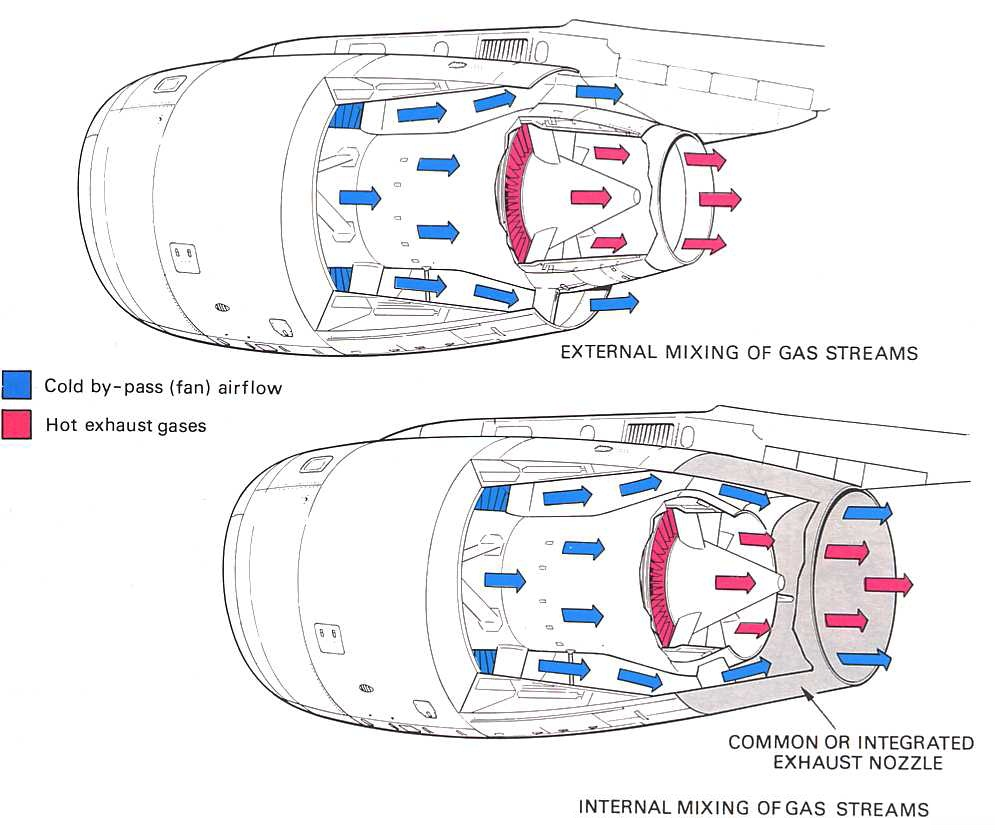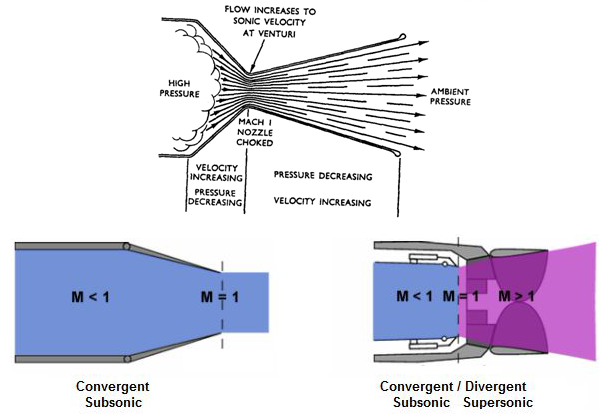Leeham News and Analysis
There's more to real news than a news release.
Bjorn’s Corner: Supersonic transport revival, Part 9
October 5, 2018, ©. Leeham News: In the last Corner we discussed the challenges an efficient inlet poses for an SST (SuperSonic Transport).
Now we go to the back of the nacelle and look at the outlet.
The engine outlet
For normal airliner engines the outlet of the engine’s air, also called the nozzle, is a rather simple design. It’s either a fixed separate outlet for the Bypass air and Core air or these are combined to a fixed Mixed outlet, Figure 2.

Figure 2. Examples of airliner engines with separate outlets (like CFM56) and mixed outlets (like IAE V2500). Source: Google images.
Mixed nozzles are slightly more efficient but increase nacelle length and by it the weight and air friction drag from the nacelle’s increased wetted area.
For supersonic nozzles, we need to have variable area outlets and therefore mixed airflow nacelles are preferred. Only one area needs to be changed.
The variable area nozzle will make sure the slow (around M0.5) high-pressure air at the back of the engine can accelerate to an optimum speed at the outlet, Figure 3.
To accelerate the air to an optimum combination of mass flow rate and speed (= thrust) we need to adjust the area of the nozzle. But for high-speed SSTs, this is not enough.
Air does not flow faster than Mach 1 through the smallest area of a converging nozzle. Once the air has reached Mach 1 it needs a diverging flow area to increase its speed further (top of Figure 3).

Figure 3. Function principle of nozzles (top) and examples of Convergent nozzle left and Convergent-Divergent or ConDi nozzle right. Source: Google images.
Convergent or Convergent-Divergent nozzle
At speeds up to about Mach 1.5, the losses of not using a Convergent-Divergent (ConDi) nozzle are small. Using a GasTurb model of the Aerion SST engine I found the difference of using a ConDi nozzle or a simpler and lighter Convergent nozzle was around 6% loss in specific fuel consumption at Mach 1.4. Analyzing engines for the Mach 2.2 Boom SST the losses increased to between 22% to 32% dependent on engine bypass ratio.
We see a Mach 1.4 SST can be designed with a simpler Convergent nozzle. It could potentially be a fixed nozzle by optimizing the nozzle for the range Mach 0.9 to Mach 1.4 if one is prepared to miss some efficiency at Take-Off and lower speeds. For a Mach 2.2 SST, a variable ConDi nozzle is a necessity.
Reverse thrust
SST’s are optimized for high-speed flight. Consequently, they have higher take-off and landing speeds. The Concorde had a final approach speed of 165kts, whereas a subsonic airliner has a final approach speed of around 135kts.
Kinetic energy increases with the square of the speed so the SST has 50% more kinetic energy to dissipate after touch down than a normal airliner of the same weight. It will, therefore, be necessary with thrust reversers for an SST.
Concorde solved the problem in a clever way. It combined the divergent part of the ConDi nozzle with the thrust reverser function, figure 4.
In the next Corner, we will look at different SST engines I analyzed with GasTurb. We can then see the discussed SST engine characteristics for different engine types.





Thanks Bjorn, looking forward to reading your next informative post. 🙂
You want to aviod turbine reversers as they are pretty maintenance heavy and get dirty. The new Saab Gripen has front wheel carbon brakes instead of thrust reverser. A SSBJ or small supersonic airliner could do the same.
There are examples of aerodynamic supersonic expansion nozzles where the amount of air sucked into the nozzle determine the supsonic jet expansion.
Fighters never had thrust reversers, except for the Saab Viggen and Panavia Tornado to meet a short runway requirement. The newer Gripen has just gone back to using flaps and canards to impeded the airflow.
To Claes and Dukeofurl,
yeah, but fighters are prepared to run higher risks, passengers in SSTs not. We don’t talk about the sunny day but when it’s slippery, even icy and windy gusts makes you keep your threshold speed up. To Slow down a 160kts SST with only wheel brakes on the typical 2100m/7,000ft runway can be tough.
That was what I was thinking, thrust reversers are practically universal even on business jets with only entry level planes like Cessna Mustang or Phenom 300 doing without
We will see what they will choose, either classical turbine T/R’s or all Wheel brakes + big electrically actuated spoilers that can increase the downforce on the wheels while being very effective at high landing speeds.
Both the Eurofighter and Gripen uses the front canards as brake spoliers at landing that also increase the downforce helping the braking action.
It’s clear from Bjorn’s comment and other business jets. Thrust reversers it is
Is it illegal to dispatch a fighter aircraft if the estimated landing distance to a full stop is more than 60% of the length of the most favorable runway at the primary or alternate airport, as is the case for jet transport aircraft? Are modern carbon brakes good enough to prevent runway requirements from increasing from those for current generation transport aircraft, if thrust reversers are not available to help with braking? Remember – a jet transport aircraft can’t be dispatched to an airport where the airplane flight manual says that it cannot be at a full stop in 60% of the available runway length at the primary or alternate destination, for estimated arrival conditions, unless the destination runways are wet, in which case the AFM full stop distance can be no greater than 52% of the available runway length.
For the 7,000 foot runway mentioned by Bjorn to be a legal destination for a jet operated by a US scheduled airline, the AFM would have to say that the aircraft being used could be at a full stop 4,200 feet down the runway for the projected arrival weight and weather if the runway was expected to be dry at arrival time, and 3,640 feet down the runway if the runway was expected to be wet at arrival time. At the time of actual landing, the require safety margin, calculated using actual arrival weight and weather, is reduced to 15%, i.e. full stop must be possible using no more than 85% of the runway.
Below are some excerpts from 14 CFR 121.195.
“(b) Except as provided in paragraph (c), (d), or (e) of this section, no person operating a turbine engine powered airplane may take off that airplane unless its weight on arrival, allowing for normal consumption of fuel and oil in flight (in accordance with the landing distance set forth in the Airplane Flight Manual for the elevation of the destination airport and the wind conditions anticipated there at the time of landing), would allow a full stop landing at the intended destination airport within 60 percent of the effective length of each runway described below from a point 50 feet above the intersection of the obstruction clearance plane and the runway.”
“(d) Unless, based on a showing of actual operating landing techniques on wet runways, a shorter landing distance (but never less than that required by paragraph (b) of this section) has been approved for a specific type and model airplane and included in the Airplane Flight Manual, no person may takeoff a turbojet powered airplane when the appropriate weather reports and forecasts, or a combination thereof, indicate that the runways at the destination airport may be wet or slippery at the estimated time of arrival unless the effective runway length at the destination airport is at least 115 percent of the runway length required under paragraph (b) of this section.”
https://www.law.cornell.edu/cfr/text/14/121.195
I don’t know about the US Air Force but where I flew (Swedish Air Force) we didn’t have any rules for take-off or landing. It was your and your bosses responsibility to make sure you could get your aircraft airborne before the trees and slowed enough to take the taxiway safely. If it was wet or icy the slowing down was dicier…, but on the Draken we have a brake chute for these cases. Viggen had reverser and Gripen has a really slow touchdown speed and good brakes with movables pressing the aircraft to the ground.
Like the whole sortie, you train for a life at the limit as safe as you can but you have to train close to the limit to learn.
Thank you Bjorn for this informative as always series and filling us in on the Swedish Airforce landing rules.
Another difference between fighter and air transport design is the number of engines commonly used. Single engine fighter aircraft are common, whereas in the US single engine aircraft are only allowed for scheduled air transport operations if the number of passengers is 9 or less. I suppose that where highest possible speed, maneuverability, and climb rate are the design goals, a single engine design will sometimes give higher performance than a multi engine design; however, performance of the multi engine design will be superior in the event of an engine failure. US Part 121 operators (major airlines) are prohibited from taking off from a runway unless it is possible for the aircraft being used to either stop on the runway or complete the takeoff in the event of an engine failure. A fighter pilot in a single engine jet ejects if the engine fails late in the takeoff run? I find it pretty hard to imagine a 737 or A320 equipped with 150 to 180 ejection seats.
From FAA Part 121.
Ҥ 121.159 Single-engine airplanes prohibited.
No certificate holder may operate a single-engine airplane under this part.”
757 birdstrike and engine failure on takeoff.
https://www.fodcontrol.com/boeing-757-bird-strike-during-take-off-captured-on-video/
F16 engine birdsrike and engine failure on takeoff.
https://www.youtube.com/watch?v=zN_Zl64OQEw
Having to stop in 60% of the available runway length may sound pretty conservative, still there are rare occasions, on really, really, bad days, when it turns out to not be conservative enough.
https://www.youtube.com/watch?v=blFw4Y1dtps
I just noticed that according to several comments that were posted on YouTube regarding the F-16 birdstrike and engine failure video that I posted a link to above, the incident actually occurred in a BAe Hawk, not an F-16.
“Not an F16. It’s a Canadian flown, British built BAe Hawk. The incident happened on 14 May 2004 while the aircraft was on a training mission involving UK Royal Air Force crew in Moose Jaw, Saskatchewan.”
Gliding to a landing in a kind of flat field after an engine failure might be an option in a small single engine piston airplane that lands at 40 to 50 mph, but I believe that typically pilots of single engine fighters that land at 100 mph or more are trained to eject if they cannot glide back to a runway or something like a dry lakebed that closely approximates a runway.
The glide characteristics of most fighters are such your likelihood of landing it safely after an engine failure is slim. You are in most cases briefed to NOT glide land it but point if possible out of harm’s way and eject while still a bit up.